
- Pottery Arts Crafts
- Brand
- Burley Winter (25)
- Ephraim Pottery (51)
- Fulper (143)
- Grele (20)
- Grueby (25)
- Hampshire (37)
- Hampshire Pottery (24)
- Handmade (100)
- Marblehead (48)
- Newcomb (26)
- Rookwood (320)
- Roseville (520)
- Studio (43)
- Teco (39)
- Unmarked (65)
- Van Briggle (157)
- Vevor (24)
- Weller (165)
- Zanesville (39)
- Zanesville Stoneware (22)
- ... (3390)
- Era
- Material
- Art Pottery (26)
- Ceramic (309)
- Ceramic & Porcelain (4)
- Ceramic / Porcelain (6)
- Ceramic Tile (4)
- Ceramic, Clay (34)
- Ceramic, Metal (5)
- Ceramic, Stoneware (17)
- Clay (1820)
- Clay, Ceramic (7)
- Clay, Pottery (10)
- Copper (4)
- Copper Over Pottery (5)
- Earthenware (35)
- Porcelain (38)
- Porcelain / China (9)
- Pottery (573)
- Stoneware (103)
- Terracotta (6)
- Wool (4)
- ... (2264)
- Subject
- Type
- Vintage
Antique c1920's Brush-McCoy Arts & Crafts Era Berries & Leaves Large Vase
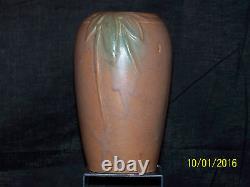
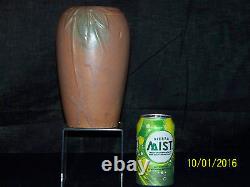
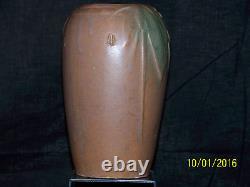
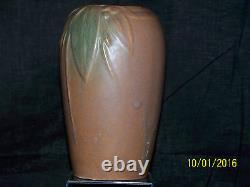
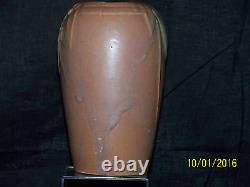
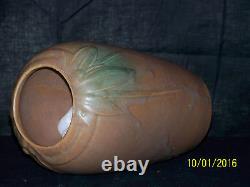
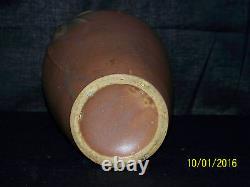
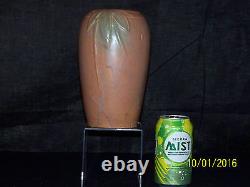
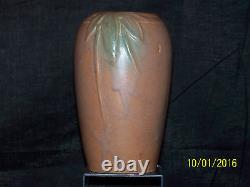


Antique c1920's Brush McCoy Arts & Crafts Mission Style American Art Pottery "Leaves & Berries" Design "Large" Arts & Crafts Vase. The glaze has run and there is a very small kiln mark but this vase is in EXCELLENT CONDITION! MEASURES: 8 1/2" x 5". The History of the JW McCoy & Brush-McCoy Potteries. McCoy was born and raised in Putnam, which is now part of Zanesville, Ohio. He was married in 1870, and the next year he and Sarah (Sade) Elizabeth Brown his wife, moved to Uniontown in Newton Township, Muskingum County. Operated a dry good store. In 1871, the McCoy's moved to the community of Roseville, Ohio.
There he entered into about a five-¬year partnership with his father-in-law, James E. Brown in a general merchandise business, which was called "Brown & McCoy". Opened a General Merchandise store on his own. In 1886, he entered into a partnership and established the Williams and McCoy Pottery Co. After about four years of operation a new partner was taken in and the pottery was renamed the Kildow, Williams and McCoy Pottery Co.
According to, "The Business Review of Muskingum County", This plant was one of the most extensive in the valley and produced all kinds of common stoneware and a variety of culinary utensils. Then in 1890, after about two more years of operation, the KW&M pottery was renamed again, and was called the Midland Pottery Co. After about two years of operation, the KW&M pottery was renamed again, and was then called the Midland Pottery Co. In 1898, following about six years of operation under the name the Midland Pottery Co. This ended the partnerships J. Had in the pottery business. Since very few pieces from these early potteries that J.Was affiliated with have been found, it is most likely that most of them were unmarked. As discussed in, The History of the W. Nelson McCoy's Blue Bird Pottery, (seen elsewhere on this Web site), Wilber F. Was a partner in the "Zanesville Hardware Company". The date that Wilber's part-ownership in the store was established remains uncertain, but it was probably between 1870 and 1875.
Along with several investors, formed a pottery solely under his name, the J. He must have devoted much of his time to his new pottery, for in 1901, he turned the management of his general store over to his son Arthur.
For several years, the J. Concentrated on the production of the simpler, utilitarian stoneware pieces. However, around late 1902 the pottery branched out and began to include the production of art pottery. The art pottery production consisted of elaborately designed, decorative items such as jardinières and pedestals, various other flower containers, umbrella stands, and sand jars. The production of these attractively glazed pieces proved to be a very successful undertaking. In 1909, George Brush joined the J. Prior to that time he had established a pottery under his own name. However, the pottery only operated about one year before a fire destroyed the entire plant. The "Brush Pottery" was not rebuilt, but he retained the remaining assets of the Brush Pottery. Later in the year after his pottery burned, George Brush became the Manager of the "Globe Stoneware Company", and the "Crooksville Clay Products Company".McCoy Pottery, within two years George Brush had become the General Manager of the pottery. Late in 1911, the officers of the J. McCoy Pottery", at the suggestion of George Brush, agreed to combine the assets of the company with those of the "Brush Pottery. Consequently, George Brush obtained the controlling interest in the J. McCoy pottery", and the name of the pottery was changed to the "Brush - McCoy Pottery.
Radford Pottery, which was located in Clarksville, West Virginia. The new name of the pottery was the Brush Pottery Co. And it operated under that name until it closed in 1982.
Article from History-JW McCoy & Brush-McCoy Potteries-McCoy Pottery Collectors Society. This item is in the category "Pottery & Glass\Decorative Pottery & Glassware\Vases". The seller is "1kul57" and is located in this country: US. This item can be shipped worldwide.
- Features: Decorative
- MPN: 750.00
- Pattern: Leaves
- Time Period Manufactured: 1900-1919
- Production Technique: Pottery
- Bundle Description: no
- Subject: art pottery
- Country/Region of Manufacture: United States
- Origin: usa
- Material: Clay
- Year Manufactured: 1920
- Model: Leaves & Berries
- Product Line: McCoy
- Main Color: Brown
- Production Style: Art Pottery
- Additional Parts Required: No
- Brand: Brush-McCoy
- Style: Arts & Crafts/Mission Style
- Antique: Yes
- Color: Brown
- Backstamp: Impressed
- Theme: Art
- Type: Vase
- Original/Reproduction: Antique Original

